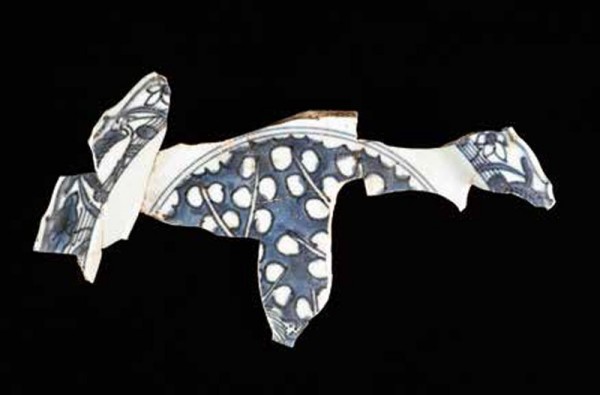
Plate, Jingdezhen, China, 1573–1605. Hard-paste porcelain. D. approx. 8". (Courtesy, Jamestown Rediscovery Foundation [Preservation, Virginia].)
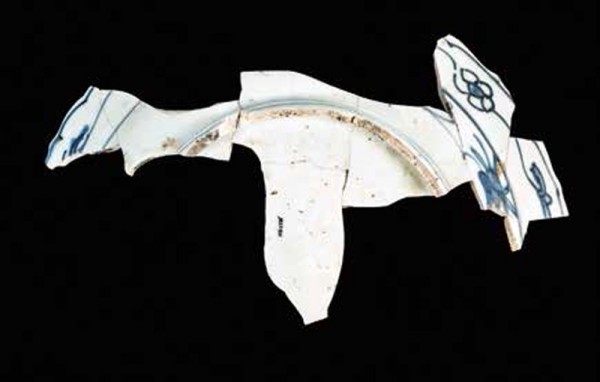
Reverse of the plate illustrated in fig. 1.
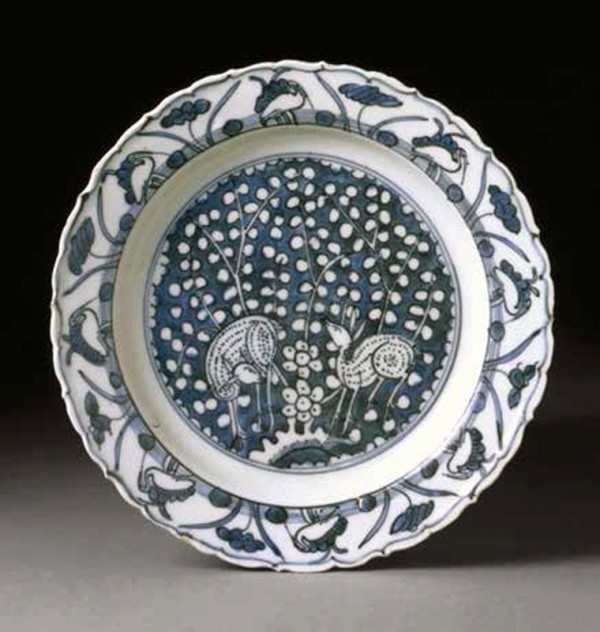
Plate, Jingdezhen, China, 1573–1620. Hard-paste porcelain. D. 8". (© Victoria and Albert Museum, London.)
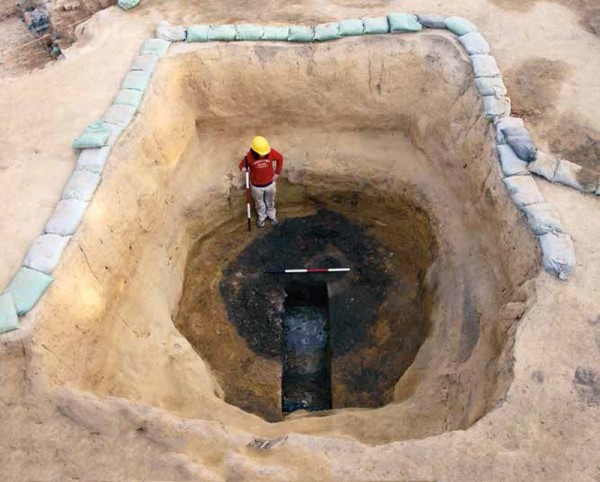
The well from which much of the plate was recovered during excavation. (Courtesy, Jamestown Rediscovery Foundation [Preservation Virginia].)
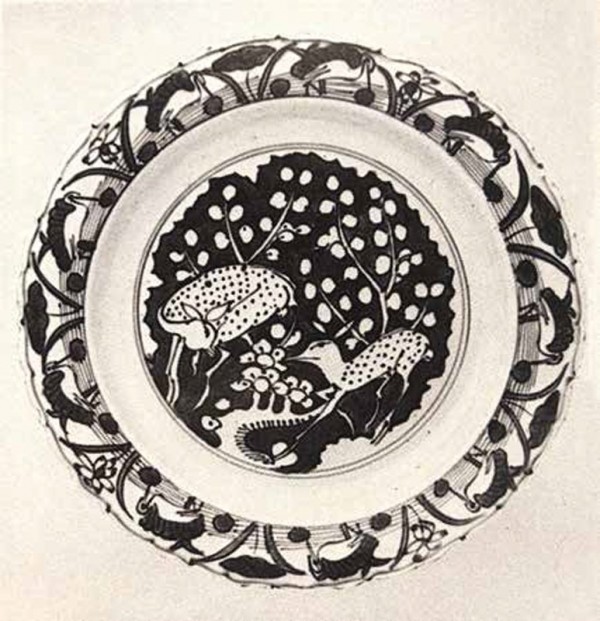
Plate, Jingdezhen, China, 1573–1620. Hard-paste porcelain. D. 8". From Takatoshi Misugi, Chinese Porcelain Collections in the Near East: Topkapi and Ardebil, 3Vols.(Hong Kong: Hong Kong University Press, 1981), 3:255.
In June 1610, a laborer in Jamestown, Virginia, shoveled several fragments of a broken Chinese porcelain dish into a well. While it is unlikely that he even noticed them, the fragments are from one of the earliest pieces of Chinese porcelain known to have reached what is now the United States of America (figs. 1, 2).[1] Made between about 1573 and 1600 during the reign of the Wanli emperor (1572–1620), the plate is an average example of what is known as kraak porcelain. Kraak was made during the late Ming dynasty from about 1570 to the mid-1640s, and typically is thinly potted and densely painted in underglaze blue with auspicious animals and Daoist, Buddhist, and Confucian motifs. Produced in vast quantities, kraak was designed primarily for export to Asia, the Middle East, and Europe.[2]
Based on comparison with intact examples, the Jamestown plate is decorated with two deer set against a stylized prunus, or plum, tree. The central scene is framed with a border of herons and lotus plants in shallow water on the rim (fig. 3).[3] As with most Chinese designs, these elements are symbolic.
Deer symbolize longevity. They are associated with Shou Lao, the Daoist god of immortality, and are said to be the only animals who can find the lingzhi, or mushrooms of immortality. They also represent a wish for prosperity, as the Chinese word for deer, lu, is a homophone of the word for the high salary of an official.[4]
Lu is also a pun on the word for road, and so two deer represents a wish that the road will be smooth, or that everything will go smoothly.[5] The prunus, or plum blossoms, in the background are a symbol of winter and a harbinger of spring, as they bloom early in the year. Like deer, they also symbolize longevity, as well as endurance and hope.[6]
The well into which the fragments were shoveled was most likely the “faire Well” ordered dug by John Smith (1880–1631) in late 1608 or early 1609 in the cellar of a small addition to the main warehouse in the center of the fort at Jamestown (fig. 4). Though he described it as being full of “excellent, sweet water,” it had gone bad by May 1610, probably the result of saltwater intrusion caused by one of the worst droughts to have ever hit Virginia.[7]
The previous winter Jamestown suffered what is known as “the Starving Time,” when food shortages, poor leadership, and a siege by the Powhatan Indians reduced the number of settlers from about 215 to just 60. By springtime, the town was in ruins: “the palisades torn down, the ports open, the gates from off the hinges, and empty houses (which owners’ death had taken from them) rent up and burned,” according to one new arrival.[8]
The newly named governor, Thomas West, 12th Baron de La Warr (1576–1618), arrived on June 10 with settlers and supplies, and the following day he “set the sailors awork to unlade ships and the landsmen some to cleanse the town.”[9] The “landsmen” (presumably the survivors along with the new settlers) used the well as a convenient dumping place for the trash that had piled up during the Starving Time.[10]
Into the well went rubble, housewares, and the bones of butchered horses, dogs, and rats. A nearby cellar hole contained the bones of a cannibalized young woman, showing just how close the colony had come to total collapse.[11] When discovered some four centuries later, archaeologists called the thousands of artifacts recovered from the well “one of the most tightly dated and varied, world-class collections of the Late Elizabethan–Early Stuart Period known.”[12] Among the housewares was a range of exotic ceramics, like this plate, that would have been unusual even in sophisticated urban centers in England at the time.[13]
Chinese porcelain first came to Europe as early as the mid-1300s, but it was not until direct trade between Asia and Europe was established about 1500 that Europeans had access to porcelain in any quantity. By the end of the sixteenth century, porcelain was readily available in Portugal and Spain, both of which, by that point, had been trading in Asia for decades. Chinese porcelain was also increasingly available in the Netherlands, especially after the establishment of the Dutch East India Company in 1602. The Company imported so much that by 1611 one observer noted that “the East India traffic has brought a large amount of porcelain to the Netherlands . . . the abundance of which grows daily, that only because of these navigations they come to be with us in nearly daily use with the common people.”[14]
While Chinese porcelain may have been readily available elsewhere in Europe, it was still rare in England in the first decade of the seventeenth century. It could be found only in tiny quantities in major port cities such as London, Plymouth, and Southampton, and even then tended to belong to members of royalty or the aristocracy, or to those with connections to maritime trade—merchants, sea captains, privateers, or pirates.[15] So who would have owned such an exotic and rare object as this dish, and how did it end up in Jamestown?
In fact, Jamestown was home to as well-traveled and cosmopolitan a group of people as could be found anywhere in the English-speaking world. The residents of the settlement included a number of gentlemen and a smaller number of ladies from England who would have known Chinese porcelain there, and who would have attempted to maintain the standards they had known back home.
Among these residents were George Percy (1580–1632 or 1633), the eighth son of the eighth Earl of Northumberland, who was one of the original settlers and, in 1609 and 1610, president of the governing council. Though Percy himself lacked great wealth, his older brother, the ninth earl, did not, and Percy was not shy about requesting fine cloths, wall hangings, and foodstuffs, explaining that such luxuries were, in fact, necessities, “it standing upon my reputation (being Governour of James Towne) to keep a continuall and dayly Table for Gentlemen of fashion aboute me.”[16] This plate would have been just the sort of elegant tableware that Percy needed to entertain “Gentlemen of fashion” in Jamestown. Period paintings suggest that he would have used it for serving food, such as butter, fruit, nuts, and cookies.[17]
Percy, like other members of the aristocracy, knew that objects signaled status, and ownership of exotic things like Chinese porcelain not only demonstrated wealth and sophistication but also proclaimed and reinforced their identity as part of the ruling elite.[18] They were, advised Governor De La Warr, tools that would “beget reverence to your authority.”[19]
The scholar David Gaimster has noted that ceramics were “among the most portable and accessible signifiers of purchasing power, taste and aspiration” in the early modern period, making them especially convenient for the Jamestown settlers.[20] Chinese porcelain and other fine tablewares would have set the wealthy, aristocratic, and cosmopolitan gentlemen and ladies apart from the rest of the population, for whom the leadership of the Virginia Company thought that “platters, dishes, spoones of wood” would be more than sufficient.[21]
But Chinese porcelain connoted not just purchasing power, taste, and aspiration in early seventeenth-century England, it also connoted connections to maritime exploration and trade. Archaeologists excavating seventeenth-century households of sailors and merchant adventurers in the East End of London have found that they are characterized by a “global signature” of Chinese, Dutch, German, French, Iranian, Italian, Portuguese, Spanish, and Turkish ceramics and other objects that their land-based neighbors, no matter how wealthy, simply did not possess.[22]
Exotic goods were acquired through legal trade, questionably legal privateering, and downright illegal piracy.[23] Legally, porcelain could have come to England directly from Asia by way of the English East India Company, which had been founded in 1600 and had a monopoly on English trade with Asia, or the Levant Company, which had been founded in 1581 and traded with Ottoman Turkey and the Middle East. There were in fact a number of people connected with both companies who had ties to Jamestown. Among them were Sir Thomas Smythe (ca. 1558–1625), governor of both the East India Company and the Virginia Company, and William Strachey (1572–1621), who worked for the Levant Company before coming to Jamestown in 1610 just at the end of the Starving Time.[24]
Porcelain also reached England through trade with Italy, the Netherlands, Portugal, and Spain, all places where porcelain was more available. The New Exchange in London advertised that its stock of porcelain would be replenished “at the next returne of the Hollanders fleete from the Indyes,” suggesting that at least some of the porcelain available in England came by way of Dutch traders.[25] Porcelain also came to England by way of English men and women who traveled to the Continent. Many of the early Jamestown settlers had traveled to continental Europe, often serving as soldiers in the Dutch wars of independence and other conflicts. John Smith, for instance, was especially well-traveled, having fought in France, Hungary, Italy, Morocco, the Netherlands, and Turkey, all places where he could have acquired Chinese porcelain.[26]
There is also a strong chance that the plate could have been booty, acquired by piracy or privateering. For many years England was at war, either officially or unofficially, with Spain and, following the union of Spain and Portugal in 1580, with Portugal as well. English privateers, with privately owned armed vessels licensed by the government to attack the ships of its enemies, captured a number of Spanish and Portuguese vessels loaded with Asian and New World goods. The amount of loot brought into England was not insignificant: the first voyage by the English East India Company in 1601 took out £30,000 worth of silver, most of which had probably been seized from Spanish and Portuguese ships by privateers.[27]
There were a number of Jamestown settlers known to have been privateers at some point during their careers. Among them was Christopher Newport (1561–1617), the captain of the Susan Constant, who made his reputation and his fortune as a privateer, capturing Spanish and Portuguese ships, including the fabulously valuable Madre de Deus, a Portuguese carrack returning from Asia in 1592, whose rich cargo included “porcellan vessels of China.”[28] Another was Bartholomew Gosnold (1571–1607), another captain and early leader in Jamestown, who had served as a privateer in the 1590s and amassed a small fortune from captured Spanish ships and their cargoes.[29]
Any one of these wealthy and well-connected people could have acquired the plate in England or during their escapades in Europe, the Middle East, or the Caribbean and then brought it with them to Jamestown to serve as a status symbol and possibly a reminder of their earlier travels. And this plate was not the only piece of Chinese porcelain in Virginia; archaeological discoveries of over a dozen small wine cups, as well as a small number of bowls and dishes in Jamestown and other early sites along the James River, show that however primitive living conditions might have been, settlers in Virginia had access to Chinese porcelain and dined and drank out of it as much, if not more so, as people in England did.[30]
There was also at least one additional piece of porcelain that was intended to come to Virginia but never made it: a small blue-and-white bowl lost in the wreck of the Sea Venture, which while en route to Jamestown in 1609 had been caught in a hurricane and sank off Bermuda. On board was the new governor, Sir Thomas Gates, and William Strachey, who had worked in Turkey, as well as other gentlemen who all would have had ample opportunity over the course of their travels to acquire Chinese porcelain.[31]
With its design of deer in a grove of prunus trees reserved in white on a blue ground, this plate is an unusual variation of one of the more common designs found on Ming blue-and-white porcelain. Dishes with deer in prunus groves painted in blue on a white ground were produced in large quantities and exported all over the globe; examples have been found in historic collections, shipwrecks, and archaeological excavations in China, Mexico, the Netherlands, Panama, Portugal, Spain, and Turkey.[32]
Even though the Jamestown example is a rare version of a common design, it was produced and exported in some quantities and was exported all over the globe. At almost the same time this plate was broken and discarded, a nearly identical plate (fig. 5) was being given by Shah Abba–s, the fifth Safavid king, or Shah, of Persia to the shrine of his ancestors at Ardebil (in present-day Iran).[33]
Two other plates belonged to the Ottoman sultans and were used at Topkapı Palace in Istanbul.[34] At least four other examples with similar central designs survive in public and private collections.[35] Dishes with the border of herons and lotus plants (but with different central scenes) have been found in such far-flung sites as Amsterdam, Lagos (in southern Portugal), and Mexico City.[36]
Chinese porcelain has been called one of the earliest truly global products, as it went to every inhabited part of the globe and influenced every culture it encountered.[37] Though perched on what was, to an English perspective, the edge of the known world, the presence of this plate in Jamestown by 1610 shows that from its beginnings, the Virginia colony was part of a global trade network that linked the Americas, Africa, Asia, and Europe.
ACKNOWLEFGMENTS My thanks to Merry Outlaw, Curator, Jamestown Rediscovery Foundation, for invaluable help with this article.
Fragments of the dish were found in several different features and levels in Jamestown fort. Most come from the first well, structure 185, layers JR2718D and JR2718H. A single sherd is from JR1425G, a layer in the west bulwark trench that dates to circa 1610. Other sherds are from JR2158X, a layer in Structure 177, the second well in James Fort that replaced the first well and which began being filled in 1611. Two further sherds were recovered from JR2361B, the bottom of Pit 6, which dates to after 1615–17, and from JR697D, a Confederate Earthwork context. Personal communication, Merry Outlaw, Curator, Jamestown Rediscovery Project, March 25, 2019.
Maura Rinaldi, Kraak Porcelain: A Moment in the History of Trade (London: Bamboo, 1989); Luisa Vinhais and Jorge Welsh, Kraak Porcelain: The Rise of Global Trade in the Late 16th and Early 17th Centuries (London: Jorge Welsh, 2008).
A similar dish is in the collections of the Victoria & Albert Museum (acc. no. C.464‑1918); see http://collections.vam.ac.uk/item/O76369/dish-unknown/ (accessed August 21, 2019).
Eva Strober, 10,000 Times Happiness: Symbols on Chinese Porcelain (Stuttgart: Arnoldsche Art, 2011), pp. 160–62.
Terese Bartholomew, Hidden Meaning in Chinese Art (San Francisco: Asian Art Museum of San Francisco, 2006), p. 138.
Strober, 10,000 Times Happiness, p. 130.
William Kelso, Jamestown, the Truth Revealed (Charlottesville: University of Virginia Press, 2017), pp. 206–10.
William Strachey, “A True Reportory,” in Jamestown Narratives: Eyewitness Accounts of the Virginia Colony, ed. Edward Haile (Champlain, Va.: Roundhouse, 2007), p. 419.
Lord Delaware, “Letter to Salisbury, rec’d September 1610,” in Jamestown Narratives, p. 466.
Kelso, Jamestown, the Truth Revealed, pp. 208–9.
Ibid., pp. 185–90.
William Kelso, Beverly Straube, and Daniel Schmidt, eds., 2007–2010 Interim Report on the Preservation Virginia Excavations at Jamestown, VA (Jamestown, Va.: Jamestown Rediscovery, 2012), p. iv.
Beverly A. Straube, “Jamestown, Virginia: Virginia Company Period,” Ceramics in America, ed. Robert Hunter (Hanover, N.H.: University Press of New England for the Chipstone Foundation, 2017), pp. 186–204.
Teresa Canepa, Silk, Porcelain, and Lacquer: China and Japan and Their Trade with Western Europe and the New World, 1500–1644 (London: Paul Holberton, 2016), pp. 203–5.
Douglas Killock, Frank Meddens, Philip Armitage, Geoff Egan, David Gaimster, Chris Jarrett, Lynne Keys, Chris Phillpotts, Ken Sabel, Rachel Tyson, and Hugh Willmott, “Pottery as Plunder: A 17th-Century Maritime Site in Limehouse, London,” in Post-Medieval Archaeology 39, no. 1 (2005): 16–25.
George Percy to the Earl of Northumberland, August 17, 1611, quoted in John W. Shirley, “George Percy at Jamestown, 1607–1612,” Virginia Magazine of History and Biography 57 (1949): 239.
Alejandro Vergara, The Art of Clara Peeters (Antwerp: Koninklijk Museum voor Schone Kunsten, 2016), pp. 67–122.
Straube, “Jamestown, Virginia.”
James Horn, 1619: Jamestown and the Forging of American Democracy (New York: Basic, 2018), p. 21.
David Gaimster, “Archaeology of an Age of Print? Everyday Objects in an Age of
Transition,” in Everyday Objects: Medieval and Early Modern Material Culture and Its Meaning, ed. Tara Hamlin and Catherine Richardson (Farnham: Ashgate, 2010), p. 137.
Ibid., p. 134.
Ibid., p. 142; Killock et al., “Pottery as Plunder,” pp. 17–19.
Gaimster, “Archaeology of an Age of Print?,” p. 142; Killock et al., “Pottery as Plunder,” pp. 17–19.
“Sir Thomas Smythe (ca. 1558–1625),” Encyclopedia of Virginia, https://www.encyclopediavirginia.org/Smythe_Sir_Thomas_ca_1558-1625 (accessed July 4, 2019); “William Strachey (1572–1621),” Encyclopedia of Virginia, https://www.encyclopediavirginia.org/strachey_william_1572-1621#its1 (accessed July 4, 2019).
David Baker, “‘The Allegory of a China Shop’: Jonson’s ‘Entertainment at Britain’s Burse,’” in ELH 72, no. 1 (2005): 174.
“John Smith (bap. 1580–1631),” Encyclopedia of Virginia, https://www.encyclopediavirginia.org/smith_john_bap_1580-1631#its1 (accessed July 4, 2019).
Stephen Alford, London’s Triumph: Merchants, Adventurers, and Money in Shakespeare’s City (New York: Bloomsbury, 2017), p. 230.
Richard Hakluyt, The Principal Navigations, Voyages, Traffiques & Discoveries of the English Nation, 12 vols. (Glasgow: James MacLehose and Sons, 1904), 7:117.
“Bartholomew Gosnold (1571–1607),” Encyclopedia of Virginia, https://www.encyclopediavirginia.org/Gosnold_Bartholomew_1571-August_22_1607#start_entry (accessed July 1, 2019).
Beverly A. Straube, “European Ceramics in the New World: The Jamestown Example,” Ceramics in America, ed. Robert Hunter (Hanover, N.H.: University Press of New England for the Chipstone Foundation, 2001), pp. 47–71; Ronald W. Fuchs II, “A History of Chinese Export Porcelain in Ten Objects,” Ceramics in America, ed. Robert Hunter (Hanover, N.H.: University Press of New England for the Chipstone Foundation, 2014), pp. 46–47; Straube, “Jamestown, Virginia,” pp. 198–99.
Canepa, Silk, Porcelain, and Lacquer, p. 259.
Ibid., pp. 138–39, 146, 198, 231, 236, 244, 248; Regina Krahl, Nurdan Erbahar, John Ayers, Ünsal Yücel, and Julian Raby, Chinese Ceramics in the Topkapı Saray Museum, Istanbul, 3 vols. (London: Philip Wilson, 1986), 2:694–95.
Takatoshi Misugi, Chinese Porcelain Collections in the Near East: Topkapi and Ardebil, 3 vols. (Hong Kong: Hong Kong University Press, 1981), 3:255.
Regina Krahl et al., Chinese Ceramics, 2:694.
One plate is in the collection of the Victoria and Albert Museum (acc. no. C.464-1918); one in the Reeves Collection at Washington and Lee University (acc. no. 2018.45.1); one in the Rijksmuseum, illustrated in Christiaan Jorg, Chinese Ceramics in the Collection of the Rijksmuseum (Amsterdam: Rijksmuseum, 1997), p. 56; and a fourth is illustrated in Rose Kerr, Phillip Allen, and Jean Martin, The World in Blue and White (London: Oriental Ceramic Society, 2003), p. 33.
Sebastiaan Ostkamp, “De introductie van porselein in de Nederlanden,” Vormen uit Vuur 180–81, no. 102 (2003): 18; Canepa, Silk, Porcelain and Lacquer, pp. 144. 242.
Robert Finley, The Pilgrim Art: Cultures of Porcelain in World History (Berkeley: University of California Press, 2010), pp. 5–7.
